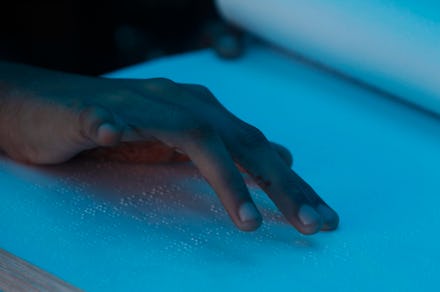Brain Scans Reveal the Way Blind People See Isn't That Different From Anyone Else

Calling Mr. Webster: We need a new definition for the verb "to see."
Recently, NPR's podcast Invisibilia explored how Daniel Kish, a blind man, uses echolocation to create mental pictures of the world around him. Kish and his skills are not only very impressive, they also remind us that our understanding of what it means to "see" is so yesterday. In fact, brain scans of those who are visually impaired have revealed that they "see" (or, perhaps more accurately, use their senses) in much the same way as everyone else.
How is this possible? It's easy to believe that sight works exclusively by taking in information through the eyes, which is then interpreted by the brain. But a study published in Cell Press challenges that notion. In 2011, researchers from Hebrew University in Jerusalem looked at brain scans of eight people who had been blind since birth as they read braille. The researchers expected that using one's fingertips to read might activate a different part of the brain than does reading with one's eyes.
Au contraire. Instead, they found that, whether you are reading with your eyes or with your hands, the same part of the brain is activated. This is big. Turns out that the brain might not be as focused around specific senses as we once thought.
Think of the brain like a house, and neurons like the furniture that fills up each room. Say the living room is the designated place for reading. Even if you were to move some of the furniture out of that room and into another, people will still go to the living room to read. Essentially, the study suggests that our brains have a set infrastructure and that the neurons that relay our senses are as movable as pieces of furniture — that is, they can come from places as disparate as our eyes and our fingertips.
What this means for mapping the brain: The theory typically goes like this: When someone loses one sense, such as sight, their other senses, such as hearing or smell, get stronger. But more and more research supports the idea that the brain actually rewires the connections from the lost sense to other regions of the brain. This reorganization, known as neuroplasticity, is what helps us to recover from injuries or adjust to new environments. To go back to the house analogy, it's like taking all the furniture from one room and finding a way to accommodate it in another.
"In the absence of vision, the world is experienced as sequences," neurobiologist Ehud Zohary of Hebrew University in Jerusalem told Live Science. While that might be a difficult concept for someone who can see to grasp, it could serve as an indicator that perhaps we are approaching brain research with too narrow a concept of what it means to see, hear, smell, taste or touch. Quite a big deal considering learning the senses is one of the very first lessons in preschool.